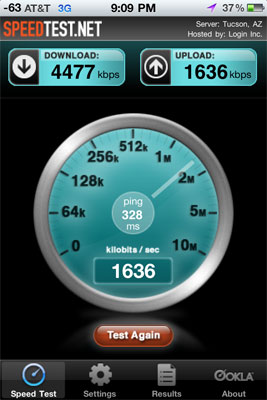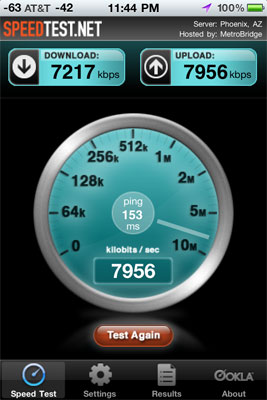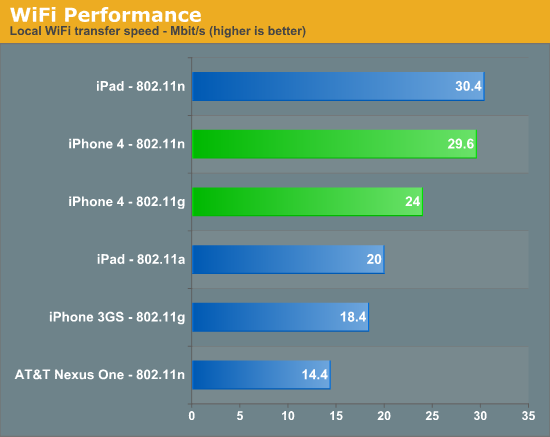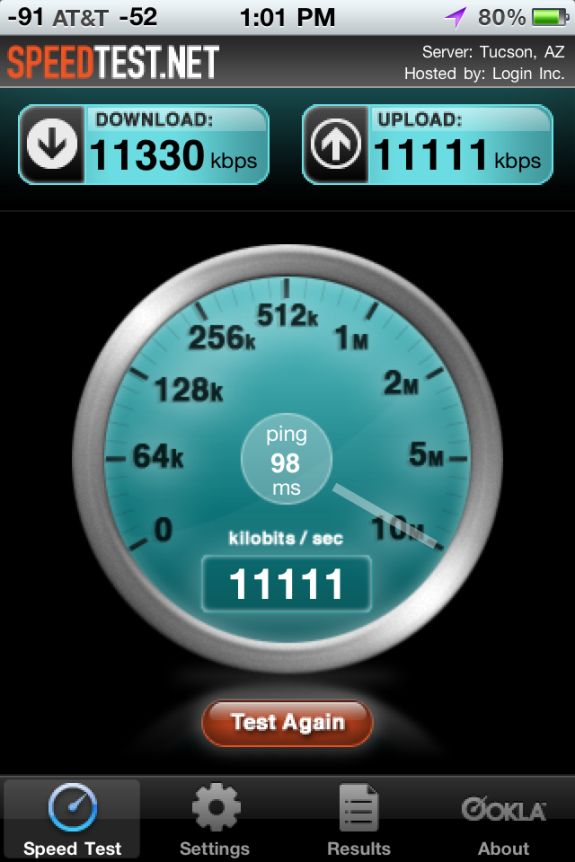Apple's iPhone 4: Thoroughly Reviewed
by Brian Klug & Anand Lal Shimpi on June 30, 2010 4:06 AM EST- Posted in
- Smartphones
- Apple
- iPhone 4
- Gadgets
- Mobile
Network Improvements
The iPhone continues to be an AT&T exclusive in the US. With the iOS 4 upgrades the iPhone 4 supports tethering over Bluetooth or USB. The feature is an extra $20 per month on top of your existing iPhone data plan and it also deducts bandwidth from the 2GB you get with the data plan. It's not a coincidence that AT&T timed the release of its iPhone tethering option with the move away from unlimited data plans. You don't have to give up your existing unlimited data plan if you don't want to, however if you want to enable tethering you have to sign up for the new $25/2GB plan.
I'm not a huge fan of iPhone tethering right now because despite paying for the service and having full signal strength on AT&T, I'm getting horrible transfer rates while trying to upload this article. I had to sign up for airport WiFi to get it live, thanks AT&T. When it does work however, it works well. As you'll see later you can easily get multiple Mbps out of AT&T's network in areas with good coverage. That easily equals the lower end of what you'd see from WiMAX today. As I've mentioned before however, it's really hit or miss with AT&T. The network is either great or totally unusable, while its competitors are generally more consistent but never quite as fast. I'd say that there's a good chance Apple will bring the iPhone to Verizon, it's just a matter of when.
| Cost of Ownership Comparison | |||||
| AT&T iPhone 4 | Sprint EVO 4G | Verizon HTC Droid Incredible | |||
| Cost of Device | $199 w/ 2 year contract | $199 w/ 2 year contract after $100 MIR | $199 w/ 2 year contract | ||
| Plan with 900 Minutes, Unlimited SMS/Data | $104.99/mo, unlimited SMS, 2GB data | $99.99/mo, unlimited SMS, unlimited data, 4G | $109.98/mo, unlimited SMS, unlimited data | ||
| Tethering | + $20/mo | + $29.99/mo | + $25/mo* | ||
| Total Monthly + Tethering | $124.99/mo | $129.98/mo | $134.98/mo | ||
| Total Cost of Ownership over 2 Years | $2718.76 | $2598.76 after $100 MIR | $2838.52 | ||
| Total Cost of Ownership over 2 Years w/ Tethering | $3198.76 | $3318.52 after $100 MIR | $3438.52 | ||
AT&T's plans are actually reasonably priced if you don't go over the data limits. A $15/mo data plan will get you 200MB of transfers per month and $25 will give you 2GB. For users like my parents the 200MB option is great. Even for me personally, 2GB is fine. I tend to peak at 700MB per month, but that's because at the office I'm almost always on my desktop or connected via WiFi. It's unclear how tethering is going to change this for me. Our own Brian Klug on the other hand easily pushes more than 2GB of transfers per month. So AT&T's rate switch is either going to save you a few bucks per month or make you really unhappy.
The iPhone 4 brings HSUPA class 6 for upload speeds of up to 5.76 megabits/s to the platform. This is a 15 fold improvement over the 384 kilobits/s maximum of the iPhone 3G and 3GS, which I routinely see. Not all AT&T markets are updated to HSUPA, and in practice I saw uploads of around 1.5 megabits/s, in line with class 2 or class 3 HSUPA.
Downstream HSDPA speeds remain unchanged from the 3GS, supporting up to 7.2 megabit/s HSDPA. I'm lucky since my market is HSDPA 7.2, as I routinely see speedtests of 5 megabits/s or above very late at night when there isn't very much plant load. I haven't seen any measurable increase in speeds over the 3GS, except in locations with very low signal as noted before.

My fastest iPhone 4 speedtest so far
Even Anand in one of the slowest 3G cities in the US saw significant improvements with the iPhone 4. AT&T's network in general seems to be improving. While the best he'd been able to achieve was around 1Mbps a year ago, these days he can break 2.5Mbps down during the evenings.

iPhone 4 speedtest in Raleigh, NC
WiFi speeds have also improved, as Apple has added 802.11n in the 2.4 GHz band. 5 GHz support remains absent, something which would have likely complicated antenna design even further. Interestingly enough, the BCM4329 WiFi and Bluetooth SoC does contain 802.11a 5 GHz support, the reason it's disabled is again likely due to antenna design constraints. The Broadcom SoC also includes an FM tuner and transmitter, though support for either remains and sadly (given Apple's historical lack of FM radio support) will remain such. Bluetooth 2.1 EDR is there as well.
The iPhone 4 seems to connect at 802.11n rates of 72 megabits/s in best case, far from the maximum without channel bonding of 150 megabits/s. This is still a welcome improvement from the 802.11b/g in the iPhone 3GS, which seemed to never connect above b rates in practice. As an aside, mobile devices using 802.11b rates (modulated using DSSS) are a huge contributing factor to WiFi congestion at conferences - I've even seen DSSS modulated rates (and thus 802.11b devices) explicitly disallowed from connecting to APs at conferences. It's a welcome improvement to see iPhone bringing N support.

A typical WiFi test result
However, even on my 25/4 DOCSIS 3 cable connection, I could only squeeze out a maximum of 8.5 megabits/s down and 8.0 megabits/s up while connected at 72 megabits/s best case. This was using the speedtest.net app to a local test location. I tried with an Airport Extreme (new generation), a WRT600N running DD-WRT, and a WRT54GL-TM running Tomato. All three showed similar results capping out around 8 megabits/s down when I could run tests in excess of 30 megabits down on my desktop. This is probably more of a CPU bottleneck appearing than anything else.
Update:
I thought there was something wrong with my WiFi performance, turns out the iPhone 4 is indeed faster than a palty 8 megabits/s. ;)
There were a number of comments by folks who were able to run speedtest.net and get throughput above 10 or 11 megabits/s. Testing earlier today on a much faster connection, I managed to get something in line with their numbers:
Early today, the folks at DigitalSociety also managed to get much faster WiFi speeds in the neighborhood of 20 megabits/s, way higher than my meager 8 megabits/s. To do so, they loaded an MP3 in safari stored on a local webserver and watched network utilization. I wish I had thought of this, because it's perfect. In the past, the speedtest.net app always used to saturate my connection over WiFi. My only explanation is that the application performs slower over WiFi in iOS 4 than it did in iOS 3, something Anand noted as well. Thanks for all the heads up messages, everyone!
I set up a similar test to DigitalSociety's. I opened an 85 MB PDF stored on my local web server in the browser of each device and watched network utilization using bwm-ng. I tested with an Airport Extreme connected over gigabit to my webserver with no other network utilization. I took the average of 5 runs on the iPad, iPhone 4, iPhone 3GS, and my AT&T Nexus One running Froyo 2.2 (which is 802.11n). The results are much, much more in line with earlier expectations.

The iPhone 4 comes close to but can't quite best the iPad, though the difference is minimal. I did notice that the iPad associates at the same 72 megabits/s connection speed as the iPhone 4. Thankfully, the iPhone 4 easily bests the iPhone 3GS. Finally, although the AT&T Nexus One associates at an 802.11n rate of 65 megabits/s, it's slower than the iPhone 3GS. I have a feeling the device is writing the PDF into flash, whereas the iOS devices are loading it into memory.











270 Comments
View All Comments
Anand Lal Shimpi - Wednesday, June 30, 2010 - link
It honestly is basic differences in UI design. Unified settings panels (iOS) vs. per-app options and global settings (Android), much more freedom to configure how you want things displayed/presented, extending all the way down to the keyboard (Android) vs. a single Apple dictated way. These are the types of things that make the iPhone more of an appliance, basically if you like Apple's approach then there's no better device for you. A *lot* of users don't, and that's where Android comes in to play. I don't believe the power and flexibility of a PC-like device is a bad thing, but not everyone feels the same way. Take a die hard iPhone user and give them your Droid, you'll probably get the same response I did when I let some of those folks use the Nexus One or EVO 4G. It's really a preference thing, it reminds me a lot of the Mac vs. PC debates.And while i haven't played with the Droid, the scrolling issue is present on the Nexus One with live wallpapers disabled as well as enabled. Although enabling them makes it worse. The HTC Incredible is the first Android phone I've used that actually improved it, although didn't solve it completely.
I expect that in the next major Android update Google will fix it once and for all. I hope.
Take care,
Anand
JAS - Wednesday, June 30, 2010 - link
Yes, "more open, more configurable" is a double-edged sword. A comparison of Microsoft Windows and Macintosh OS X is apt in this regard.P.S. -- Can we advance beyond the juvenile label of "fanboy" when criticizing a person's like for a product?
bplewis24 - Wednesday, June 30, 2010 - link
Juvenile comes with the intent. I have the utmost respect for Anand and his opinion/reviews. If you take "fanboy" as a disparaging remark, fine, but it essentially means you have a bias or preference that obscures some of your objectivity.Brandon
The0ne - Wednesday, June 30, 2010 - link
As I've often expressed here, I like the reviews to not have any 1st person views. I don't care if one waited for 6hours for a phone. I don't want to hear any "this phone is the all to be". I just want a detail review of the phone and it's features. If one can qualify and/or quantify the differences with other products great. If you can't then don't, rather then having the innate urge to add your own opinions.Yes, the apple UI is more smooth, the experience is more enjoyable. The druid UI is a tad slower but by no means going to destroy or ruin anyone's experience. If you can't justify it, don't!
Lastly, the problem with 1st person perspectives being included in reviews and especially technical reports is that the reader will see it as favoritism. This is why absolutely NO credible technical and scientific review/report is written this way. I don't write my engineering tests and reports in 1st person. Just stick to the material and leave opinions out of it. This type of review ONLY happens online and sadly it's affecting technical and scientific materials as well.
Do the job, state the facts and tests and let the reader decide how to deal with it. Don't offer the reader any types of suggestion or persuasive comments. If you do include it, like other websites, in the editorial section or something similar.
kmmatney - Wednesday, June 30, 2010 - link
I wouldn't want to read reviews that just state facts. I'm an engineer/scientist and have written many peer-reviewed scientific papers. For tech reviews, though, I really appreciate user experience. There are just too many intangibles that can't be expressed by facts and tests. That's why I have been reading Anadtech for over 11 years - I appreciate the blend of techiness and user experience.totenkopf - Wednesday, June 30, 2010 - link
I have to agree with TheOne on this. Also, you can express "intangibles" without using the first person... If the iPhone's UI feels smoother than another phone then just say that and leave off the "I feel" bit.Remember that any statement comparing the iPhone to "Android" will have its flaws. You can only compare the iPhone 4 to other phones, not android. Any such statement will inherently be some form of generalization. Besides, Comparisons made with particular Android phones will be far more helpful as many android phones offer an experience distinct form any other Android phone.
It's really not that uncommon for iPhone users to play with an Android phone and really like it. Many of them actually seem quite surprised that they actually like it; some merely think that iOS is the only show in town as it has been the best for a long time. Widgets, in particular, offer a lot of customization and, perhaps just as importantly, personalization, that many iPhone users seem to appreciate. If used correctly, widgets can multiply the functionality of your phone many times over, and in some cases preclude running many apps at all. That said, setting up an android with just the way you like it and hunting down the newest and best apps and widgets can be an ongoing struggle. However, many people will enjoy it immensely if for no other reason than to make their phone that much better in their own eyes.
There! My experience with android without sounding too biased... I think ;) It certainly sounds better than "Android rulz 'cus widgets are soo good and apple doesn't even have them because apple is fail!"
John Sawyer - Thursday, July 1, 2010 - link
As an iPhone user for the past year, I can concur with your observation that many iPhone users would be impressed with the latest Android phones. I've tried the Evo for about ten minutes, and during that time, I did some web browsing, ran some apps, etc., and it was fast (even with a 3G connection), seemed polished, and I wouldn't complain too much if it was the only phone I had to use. If I had the chance to use it longer, I might start seeing its deficiencies, but a quick look, looked good.Though a week later, the iPhone 4 was released, and I was blown away by its display, which no other phone matches yet, though I'm somewhat biased about that since I like to be able to read tiny text.
The0ne - Thursday, July 1, 2010 - link
The problem with user experience is that it's just that and it affects how readers perceive the product. I don't mind really that reviews are done this way, but many are done extremely bad. Here are a few examples of comments people include in their reviews..."I let me wife play with it for a day or so and she loves it!" This is quite common for PMP player reviews.
"This is the best thing ever to come out on a phone..." Best thing is more or less an exaggeration. Way too many improper adjectives are used in reviews. Anandtech is no exception to this.
"I like it..." Okay, that means what, I should too?
strikeback03 - Thursday, July 1, 2010 - link
I disagree, in that I think the subjective "feel" of one phone (and OS) relative to another is largely subjective and can't be quantified in just plain numbers. Would you really feel better if he stated that "after observation with a high speed camera phone X illustrates a scroll with 5 frames and phone Y does so with 20" as opposed to "phone X is noticeably choppier"? Or say for example Sprint shipped a special edition EVO with 768MB RAM, we know that is 50% more, but would it actually make a difference in your interaction with the phone if you had less than 20 apps open?I have an HTC Touch Diamond, a WM 6.1 phone with TouchFlo 3d. None of the reviews I read before purchase adequately described how clunky the interaction between the TouchFlo plugin and the background OS is, or how poorly optimized WM6.1 is for a touchscreen, and certainly not how the speed of the device goes from marginal when new to completely unacceptable after a few months and requires a hard reset to restore.
ipredroid - Saturday, July 3, 2010 - link
What many fail to realize is with out opinion there would only be numbers and no reason to have site with user friendly technical data (a site like this). Everyone's opinion is biased or influenced by something, simply sticky by facts and zero emotion devoted towards every product is impossible. Many opinions itself is laced in bias preference for facts.I for one want as much information as possible not half the information.
Facts and opinions have and always will be better than just one of them. Would you rather have technical data about someones trip to Mt. Everest or an opinion. I would want both, so would everyone else or else you are missing facts.
Science and opinion go hand in hand. Cause and effect.